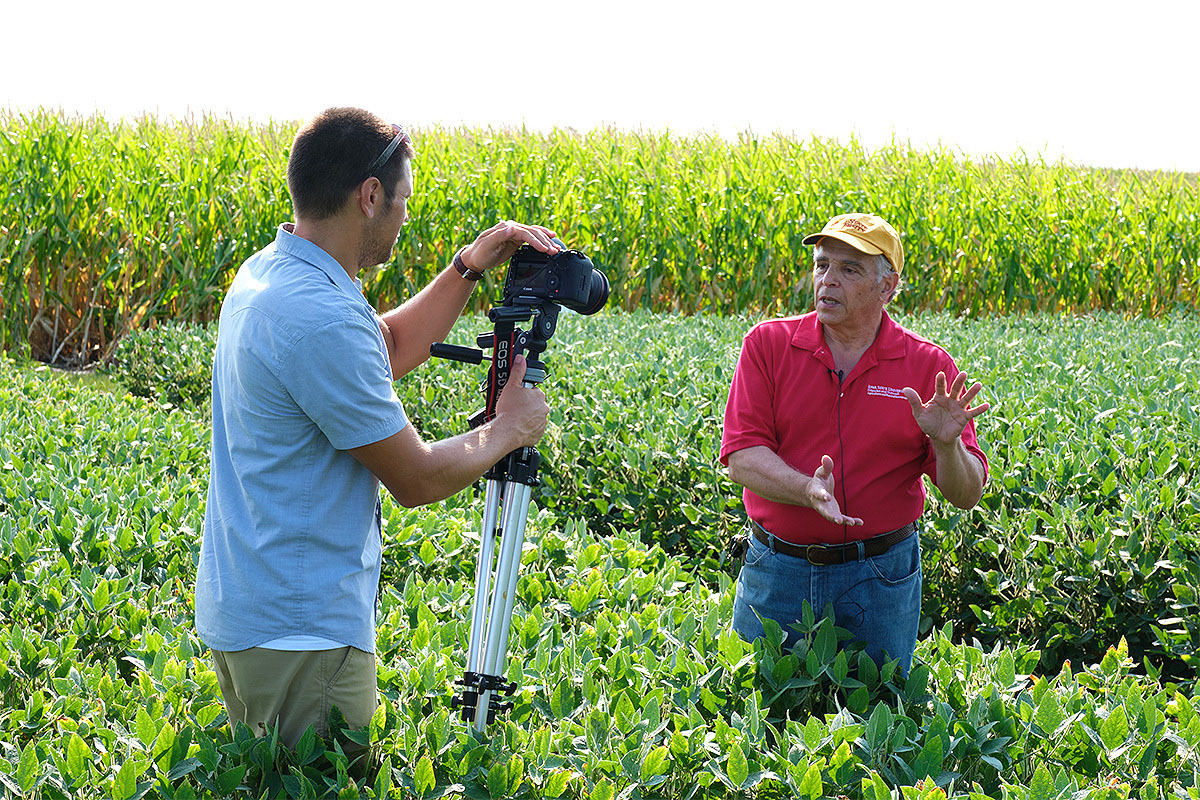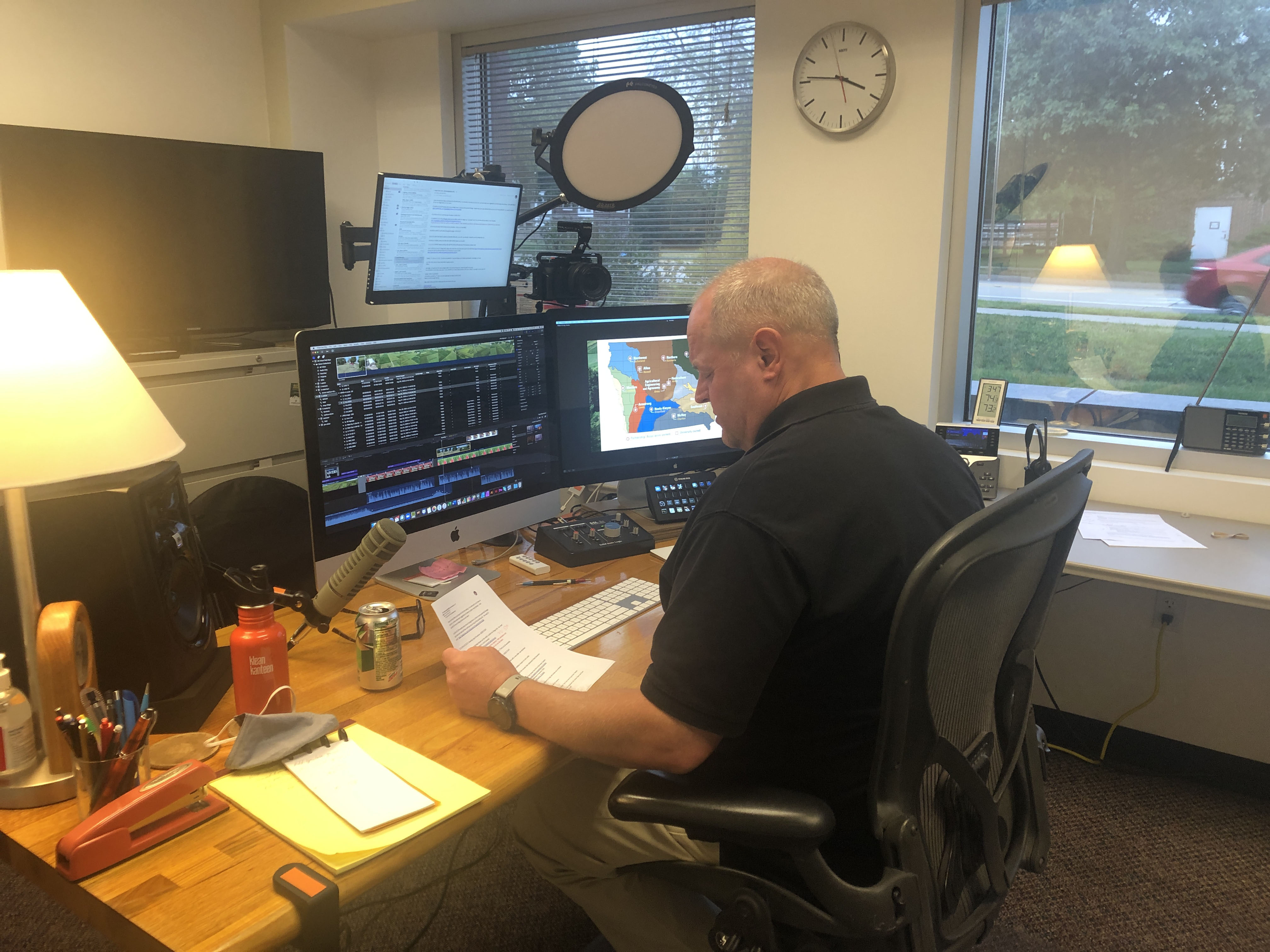
Videographer Brandon Kleinke and extension soil fertility specialist and professor of agronomy Antonio Mallarino record video at the Field Extension Education Laboratory west of Ames. Provided photo
By Jeff Budlong, Inside Iowa State
When the pandemic forced ISU Extension and Outreach to close offices last spring and cancel most in-person meetings, it impacted connections with Iowans across the state.
Instead of pulling back, extension found new ways to reach its audience and draw in others along the way.
"We started using social media, podcasts and even radio to reach people with educational information," said vice president for ISU Extension and Outreach John Lawrence. "It is more than just Zoom or Webex, it's a portfolio of ways we reach people in addition to in-person."
Extension had the advantage of previous relationships with its audience, and its affiliation with Iowa State guided people to virtual offerings.
"They will follow us on social media and they will tune in to watch a webinar even though they may not like Zoom. Because it's the same entomologist they would have driven 60 miles to hear because they trust them," Lawrence said.
For all the virtual education extension offers, it will not totally replace the in-person experience, Lawrence said.
"It's about the relationships," he said. "Our staff likes to help people and most are extroverts. Those personal connections and trust can be generational."
Successful offerings
Extension provided numerous opportunities for people to interact virtually in recent months.
Spring's crop scouting school was held virtually for the first time and drew 560 participants, up from about 30 for in-person events. People from multiple states and Canada took part.
The beef team conducted an 11-part series on controlling cow costs on Facebook that had more than 1,500 views. Iowa Learning Farms had 11 virtual field days with 2,300 participants, and August's research farm field days had 1,058 participants from nine states.
One of the biggest challenges of going virtual with field days was traveling to each field site to record video for a presentation. Extension tapped into employees' talents to get drone footage of the fields, supplemented with data slides to aid presentations.
"From day one of the pandemic, it has been how fast can we get technology in people's hands," said program services coordinator for ag and natural resources Brent
Pringnitz.
Extension also made its experts available to a larger audience with its Facebook Live Q&A sessions beginning in May. The events are live but can be seen through archives, allowing viewers to take in the information on their schedule.
It allows extension to reach a new generation of younger people more likely to consume information on their phone or tablet than walk into their local extension office.
"In a virtual world there are no boundaries," Lawrence said. "Going forward we will look where Iowa State may have particular strengths and has a national audience to engage. Conversely, are there things we are not particularly strong in where we may partner with other state extensions to deliver programing?"
Quality matters

Extension coordinator for program services for ag and natural resources Brent Pringnitz works on editing video to be used during ISU Extension and Outreach’s Research and Demonstration Farms Virtual Field Days. Provided photo
Lawrence said extension benefited from starting early with virtual offerings, and quality will be key to keep the audience.
"Early on we had a lot of grace, but as we move on it probably needs to be better quality and branding," he said. "There was a lot of learning from each other and not just in Iowa, but seeing what other states were trying to do."
That is why extension unveiled CropsTV on Dec. 1. It provides crop production information directly to farmers and agribusinesses at the viewers' convenience. Forty-five topics will be delivered over the course of 10 weeks and can be viewed live or on-demand anywhere there is an internet connection. It has a one-time payment of $45 to help offset the loss of the crop management conference and the crop advantage series, which draw thousands of participants.
"It is an important part of our budget with revenue generation," Lawrence said. "It provides continuing ag credits that our audience needs, and provides us a test run of something with a professional look."
Lawrence also sees the possibility of something similar to CropsTV for community development, human sciences and 4-H.
Virtual education task force
To examine the work done in the transition to virtual education, Lawrence formed the Virtual Education Task Force. The 17 members of the task force assessed extension's response and programing while dealing with COVID-19, and reported successes and areas where more work is needed.
"We wanted to see what was and wasn't working well, and in the short-term shared those ideas," he said. "We all realize that when we go back to normal, it won't be the old normal."
Extension will continue to work on improving its delivery methods, virtual program and responsiveness going forward.
Read the series
Learn more about ISU’s pandemic response in a collection of stories highlighting some of the hard work, dedication and collaboration across campus.